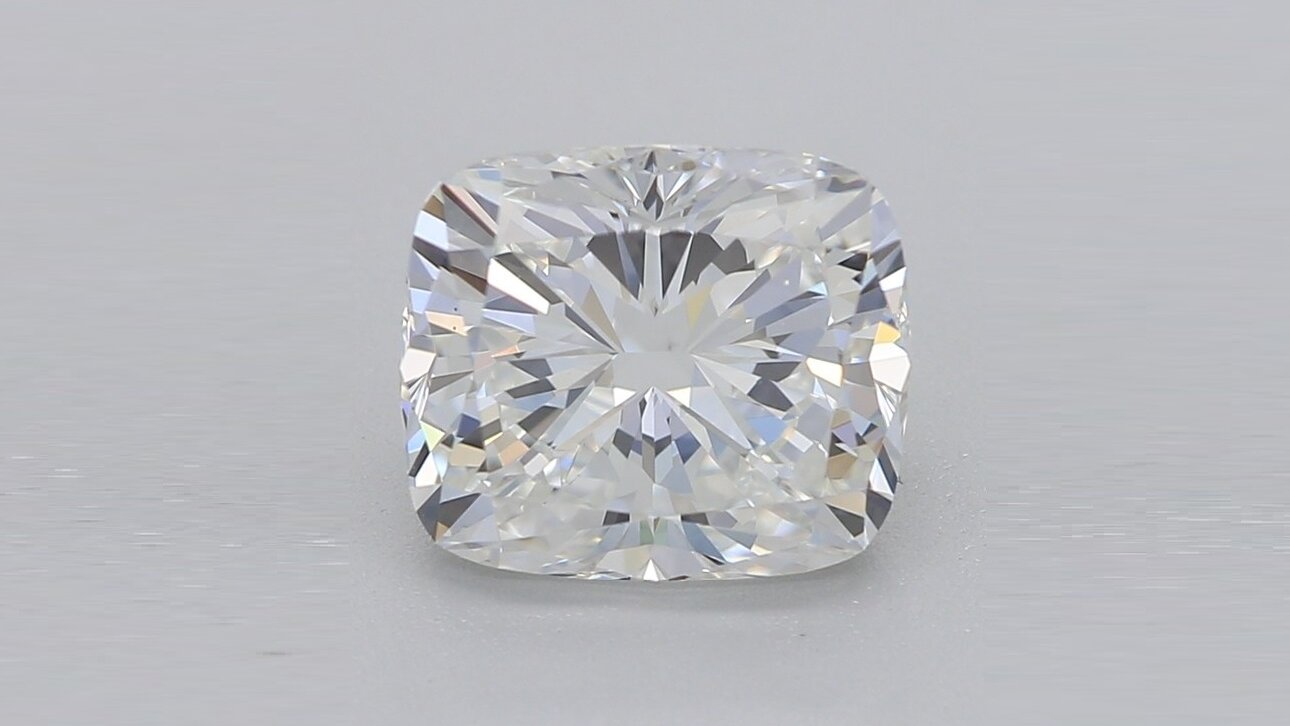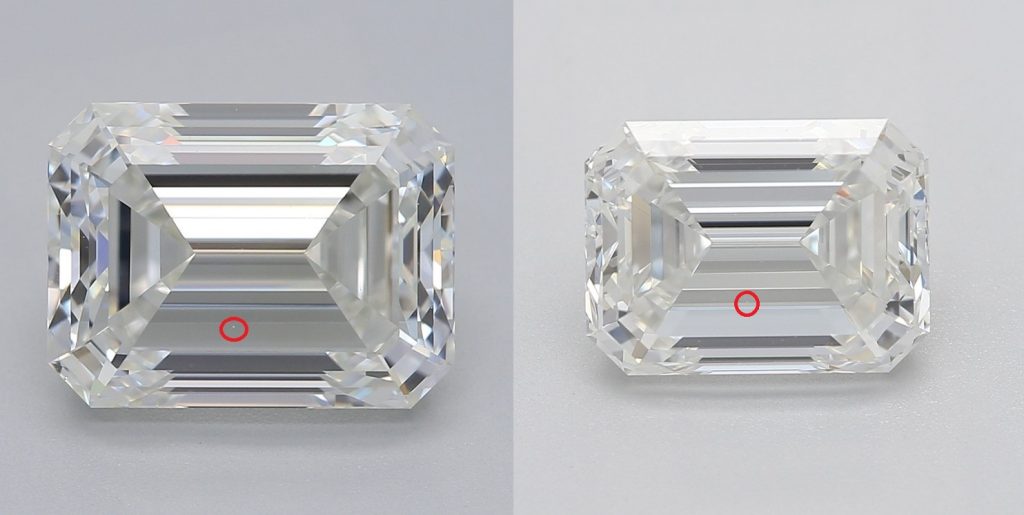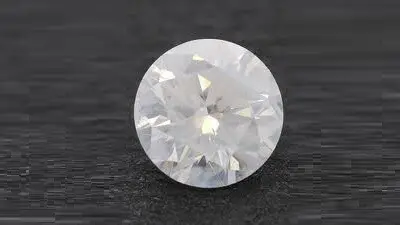Are VS1 Diamonds Right For You?

By Gary A.

Edited by Olivia H.
Published Jul 27, 2022
Edited on Dec 17, 2024
Striking the perfect balance between beauty and value, VS1 diamonds offer exceptional clarity that’s nearly flawless to the naked eye, making them a popular choice for engagement rings.

- 7 Quick Tips for Buying a VS1 Diamond Engagement Ring
- Introduction
- Why VS1 Diamonds Are So Popular
- VS1 Clarity Meaning and Appearance
- VS1 Diamond Price
- Our Expert Take
- 10 FAQs
Before we dive deeper into the specifics, here are some practical tips to help guide your decision-making process:
7 Quick Tips for Buying a VS1 Diamond Engagement Ring
When selecting a VS1 clarity diamond for an engagement ring, certain aspects are crucial to ensure you get the best value and appearance. Here are essential tips to guide you through this process.
- Tip 1: Understand the VS1 Clarity Grade VS1 Defined: Learn what VS1 clarity means. VS1 diamonds have very slight inclusions that are not typically visible to the naked eye. Understanding this grade helps set realistic expectations.
- Tip 2: Examine the Diamond Under Different Lighting Conditions Varied Lighting: Look at the diamond under different light sources. Natural light and store lighting can affect how inclusions appear. Sometimes, what’s invisible in one light setting might be slightly noticeable in another.
- Tip 3: Request a Loupe or Magnifying Glass Use Magnification: Request a jeweler’s loupe or magnifying glass to inspect the diamond closely. While VS1 inclusions are minor, using magnification can help you see the location and type of inclusions, impacting your decision.
- Tip 4: Consider the Diamond’s Cut and Shape Impact of Cut and Shape: The cut and shape of a diamond influence how inclusions are seen. Brilliant cuts like round or princess can hide inclusions better than step cuts like emerald or Asscher.
- Tip 5: Pay Attention to the Diamond’s Size Size Matters: The larger the diamond, the more likely inclusions might be visible. For VS1 diamonds above 2 carats, pay extra attention to the clarity as inclusions might become more noticeable.
- Tip 6: Check the Diamond Certification Certification is Key: Always check the diamond’s certification (preferably GIA or AGS). The certificate provides a detailed map of the diamond’s inclusions, offering insights into their size, location, and impact on the overall appearance.
- Tip 7: Assess the Diamond’s Overall Appearance Overall Aesthetics: Beyond clarity, assess the diamond’s overall appearance. Ensure the diamond aligns with your preferences in terms of brilliance, fire, and how it complements the ring setting.
Now that you’ve got these practical tips, use Jeweler AI below to find the perfect engagement ring that suits your style and budget:
Introduction
From the moment you first started trawling the internet for clues over how, where, and when to start looking for an engagement ring, you’ve probably seen the subject of diamond clarity raised more than almost any other. Chances are, however, that you’re still not clued in when it comes to what clarity means, and why it matters so much to your future diamond engagement ring.
In reality, the term ‘clarity’ refers to just one aspect of any given diamond – but it’s a pretty significant one. Representing the absence (or, of course, presence) of flaws within a diamond, understanding the clarity grades enables you to make a reliable, quick, and simple judgement over any diamond’s quality.
These flaws, known as inclusions, can be so small that we would never see them without a magnification tool – or they can be big enough to impair or undermine the beauty of a stone. To that end, they can be small enough to entail a high ticket price, or big enough to make the diamond far, far less valuable on the market.
VS1 diamonds are, by definition, diamonds that feature inclusions, and yet they are still one of the most coveted categories of diamonds on the market today. Why? Because, while it’s not perfect, a clarity grade of VS1 offers a great level of reassurance that most of the inclusions are barely noticeable to the naked eye.
Why VS1 Diamonds Are So Popular
If a diamond is labeled as VS1, this specifically refers to its clarity (more on that below) or, more specifically:
- It will have been given a clarity grading of Very Small Inclusions 1 on the GIA Clarity Scale
- Its inclusions will be only rarely visible by the naked eye, but usually too small to see, meaning that…
- It will likely be eye-clean unless it is exceptionally large – large enough for inclusions to be far more noticeable.
- It will generally be less expensive than VVS (Very very slightly included) diamonds
- It will generally offer the same beauty as a VS2 diamond
You can browse all VS1 diamonds here, or read our full guide to this popular clarity grade below.
VS1 Clarity Meaning and Appearance
To understand what a VS1 diamond grading is, it’s important to first understand the most reputable scale used for evaluating a diamond’s clarity – the GIA grading scale, which will be something that you will need to continuously refer back to until you have settled on the right diamond for you.
Deciphering the GIA Clarity Scale
The diamond clarity scale for GIA contains the following grades, with VS1 located between VVS2 and VS2:
Internally Flawless (IF), Very Very Small Inclusions 1 (VVS1), Very Very Small Inclusions 2 (VVS2), Very Small Inclusions 1 (VS1), Very Small Inclusions 2 (VS2), Small Inclusions 1 (SI1), Small Inclusions 2 (SI2), Inclusions 1 (I1), Inclusions 2 (I2).
The Role of Clarity in Diamond Valuation
A diamond’s clarity can affect its price, since any noticeable inclusions – even if they are very, very minor – will decrease its value on the market.
But what about eye-clean diamonds? We’re pretty sure you’ve already seen a few mentions of those – and for good reason.
Eye-clean diamonds are not represented by their category, since eye-cleanliness entails a certain degree of subjectivity. What an experienced jewelry maker – like our partner A. Jaffe, who has been working with diamonds for 130 years – sees is going to be pretty different to what you see, after all.
Diamonds that the majority of us would consider eye-clean are included within the clarity spectrum and can be found in various grades, even as low as SI1 or VS2 diamonds. Not all VS2 or SI1 diamonds will be eye-clean, as this depends on other factors too, but it is entirely possible to find them at these lower grades.
Unraveling VS1 Clarity
VS1 is the fifth grade on the GIA Clarity Grade Scale. It stands for Very Slightly Included, meaning that, while a VS1 graded diamond does feature ‘birthmarks’ within its internal structure, these birthmarks are still incredibly minor, and barely noticeable.
Diamonds with a VS1 clarity grading typically only have inclusions that are just barely visible under 10x magnification. And, even with magnification, it can take several seconds until the blemish spot is located.
Inclusions with a VS1 grading are hardly noticeable to the naked eye, especially in diamonds that are less than 2.0 carats. A VS1 diamond is one of the most affordable diamonds you will find without any visible inclusions.


VS1 vs VVS: A Close Look
The main difference between a VS1 diamond and a VVS diamond is the price since the physical exists on such a small scale (usually only visible under 10x magnification). This is why VS1 is such a great idea for shoppers.
As we mentioned in the previous section, VS1 diamonds are less expensive than VVS diamonds. Both diamonds are eye-clean, but the inclusions on a VVS diamond are harder to see than on a VS1 diamond – although, of course, both require magnification to see the inclusions.
So, if you are more concerned with price – and with ensuring that your money goes toward the tangible factors, rather than what’s printed on the GIA report – the VS1 diamond is the best choice. If clarity is more important, then a VVS diamond is the better choice.
A VVS1 or VVS2 diamond will cost significantly more than an otherwise similar VS1 diamond, although, visually, there will be very little difference between them.
For many buyers, VVS diamonds rarely turn out to be worth the premium price they fetch on the market. Since VVS is just one grade below Internally Flawless – and rare in their own right – they’re pretty highly regarded among those who spend their lives studying these fascinating gemstones.

They can, however, cost up to 20% more than comparable diamonds graded at VS1 – and, for the average buyer looking to find the ideal center diamond for their engagement ring, this 20% price hike is rarely worthwhile.
For instance, the average shopper would find it pretty difficult to spot the difference between this 3.01 Carat H-VS1 Cushion Diamond and this 3.02 Carat G-VVS2 Cushion Diamond – unless, of course, they took a look at the price, which could be significantly higher for the second diamond.
VS1 and Lower Clarity Grades
As a general rule of thumb, VS1 is that ‘sweet spot’ that we would recommend the majority of shoppers aim toward. It’s not perfect, so you’re not paying for perfection, but it’s also not imperfect enough to appear imperfect to the naked eye, so you’re not paying for visible flaws, either.
Sure, the difference between one clarity grade and another is pretty marginal, but, in this instance, it’s enough to spell the difference between eye-cleanliness and a minor (though perceptible) imperfection.
These days, many shoppers are looking to impress their brides-to-be with an above-average size diamond, and that means that any imperfections on or within the diamond are a little easier to spot. This is another reason why VS1 is generally considered better than VS2 since, while the latter can produce eye-clean diamonds, it can impact the appearance of a stone more if that stone boasts a large carat weight.
Just keep in mind that eye-cleanliness is key to a good diamond. Digital images are often made larger so that you can inspect the diamond as much as possible over the internet, but that can also mean that very minor inclusions look far more significant, and could lead to you turning away from a beautiful diamond.
eye-cleanliness in VS1 Diamonds
In the majority of diamonds, a clarity of VS1 will mean that your diamond is eye-clean.
This is a great yardstick with which you can judge the quality of a diamond before you see it in person, but eye-cleanliness is (by definition) always in the eye of the beholder. Diamonds have their personalities, and you can only judge the full scope of a diamond’s beauty in person.
For instance, this 1.81 Carat F-VS1 Princess Diamond looks pretty much flawless on screen – and it’s not at all difficult to imagine that mesmerizing sparkle, so unique to the princess cut, sitting proudly in the center of an engagement ring like this Princess Cut Solitaire Engagement Ring in Yellow Gold.
Use the GIA diamond reports as a way of ascertaining whether or not a diamond is up to your standard, but let eye-cleanliness play a central role in your final choice.
Do VS1 Diamonds Sparkle?
Yes, provided they have an excellent and symmetrical cut.
Clarity only begins to impact a diamond’s sparkle when the inclusions and blemishes are far more severe than they are in VS1 diamonds. For sparkle, you need to be discerning about cut and, to a lesser extent, the type of setting you pick for your engagement ring.
VS1 Diamond Price
So, you know where VS1 sits on the spectrum, and how it appears compared with other clarity grades, but chances are you’re still looking for more concrete terms. To that end, here’s what you need to know about actually paying for a VS1 diamond.
What is VS1 Diamond Clarity Worth?
There’s no set VS1 diamond price, as each diamond’s cost depends on many other factors, too. You can expect to pay anywhere between $3,000 (or slightly less, although this would suggest a low grade for another of the four Cs) and $10,000 – or more.
VS1 clarity diamonds are generally considered eye-clean so, even though they do feature inclusions, they still command a high price on the market. They’re more common than IF and FL diamonds, but popular enough among those looking to purchase engagement rings featuring nearly flawless diamonds that they have earned a premium price.
Still, they remain a much, much more affordable option than diamonds that have been graded even just one step higher than VS1…
Is VS1 More Expensive than VS2?
In general, yes. A VS1 diamond will typically cost about 10% more – unless, of course, that VS1 diamond is significantly smaller, or features a low color grade.
Some VS1 diamonds that suffer from poor color, or a very low carat weight, will cost less than diamonds with a lower clarity grade. In general, though, the higher the clarity grade, the more expensive the diamond will be.
Our Expert Take
VS1 is a great clarity grade to aim for – and, in our opinion, the definitive sweet spot between ‘too much’ perfection (and the high cost of it), and too many flaws. Even so, its beauty can be rivaled by diamonds with the ever-so-slightly lower clarity grade of VS2, which is something to keep in mind as you tailor your search to your budget for this ring. If you’ve got a relatively restricted budget, then a VS1 diamond ring is a great option.
The fact that VS1 is widely regarded as a good middle ground between both ends of the GIA Clarity Scale means that it can command its premium price on the market, although this price will still be substantially lower than a VVS diamond.
In our opinion, the high regard VS1 diamonds have earned among jewelers is worth the extra investment – provided, of course, that it does not come at the cost of one of the other four Cs.
10 FAQs
- Q: What Does VS1 Clarity Mean in Diamonds?
A: VS1 clarity indicates that a diamond has very slight inclusions, which are difficult to see under 10x magnification and typically invisible to the naked eye. - Q: Are VS1 Diamonds Eye-Clean?
A: Yes, most VS1 diamonds are considered eye-clean, meaning their inclusions are not visible to the naked eye. - Q: How Does VS1 Clarity Affect a Diamond’s Value?
A: VS1 clarity contributes positively to a diamond’s value, offering a good balance between high clarity and affordability compared to higher grades. - Q: Is VS1 Clarity Better Than VVS2?
A: VS1 clarity is slightly lower than VVS2. The choice between them depends on personal preferences for clarity versus cost. - Q: Can You See Inclusions in a VS1 Diamond?
A: Inclusions in VS1 diamonds are usually invisible to the naked eye and can only be seen with magnification. - Q: What is the Difference Between VS1 and VS2 Clarity?
A: VS1 clarity diamonds have fewer and smaller inclusions compared to VS2, making them slightly higher in clarity and value. - Q: Should I Choose a VS1 Clarity Diamond for an Engagement Ring?
A: Yes, a VS1 clarity diamond is an excellent choice for an engagement ring, offering a great combination of beauty and value. - Q: How Important is GIA Certification for a VS1 Diamond?
A: GIA certification is crucial as it assures the diamond’s clarity grade is accurately assessed and internationally recognized. - Q: What Types of Inclusions are Common in VS1 Diamonds?
A: Common inclusions in VS1 diamonds are minor, such as tiny feathers or pinpoint blemishes, typically not visible without magnification. - Q: Is a VS1 Diamond a Good Investment?
A: While diamonds are generally not primary investment vehicles, VS1 diamonds hold their value well due to their desirable clarity and appeal.
Discover your perfect VS1 diamond with Jeweler AI’s tailored recommendations – experience the blend of AI precision and personal touch.
FOLLOW-UP GUIDE SERIES





















